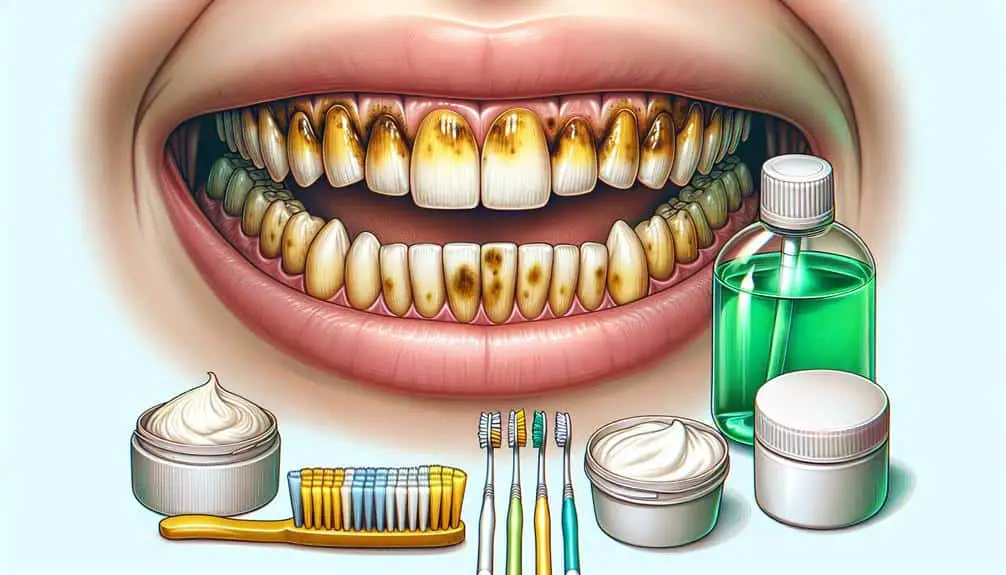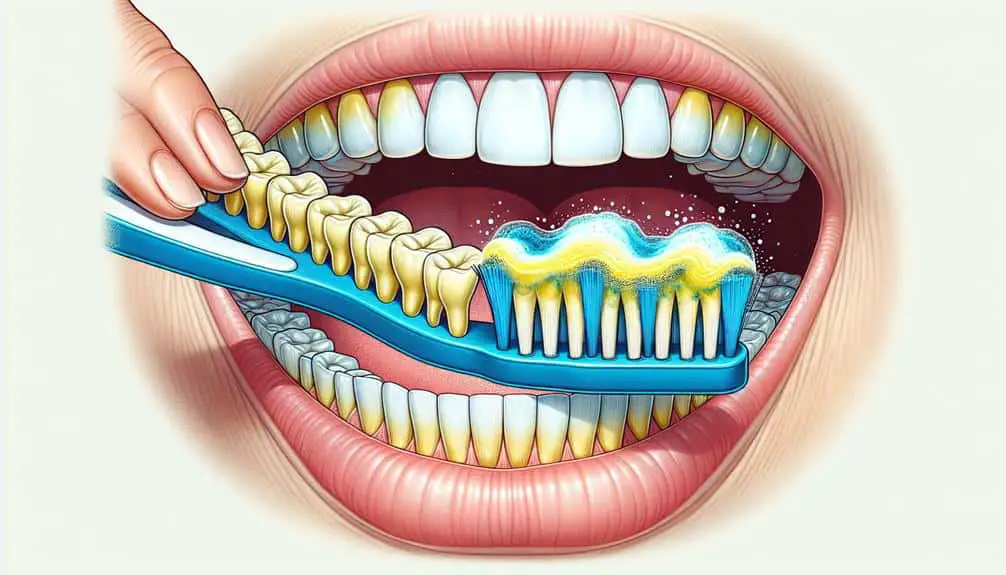To address fluoride-stained enamel effectively, consider professional whitening treatments like laser therapy or enamel bonding. At-home kits with bleaching agents can also lighten discoloration, but consult a dentist first. Natural remedies like oil pulling or baking soda might help, but seek professional advice. Dental procedures such as whitening or veneers offer long-lasting results. Maintain brightness by brushing with fluoride toothpaste and watching your diet. By combining these solutions, you can tackle fluoride-stained enamel thoroughly for a brighter smile.
Key Points
- Professional whitening treatments like laser therapy effectively remove fluoride stains.
- Enamel bonding can cover and restore fluoride-stained enamel to its natural appearance.
- At-home whitening kits containing bleaching agents can lighten fluoride stains.
- Natural remedies such as oil pulling and baking soda can help reduce fluoride stains.
- Dental procedures like veneers offer lasting solutions for fluoride-stained enamel.
Professional Whitening Treatments
If you're looking for effective solutions for fluoride-stained enamel, professional whitening treatments offer a thorough option to restore the natural color of your teeth. Among the techniques available, laser therapy and enamel bonding stand out for their efficacy in addressing fluoride stains.
Laser therapy involves the use of concentrated light energy to break down the stains on the enamel, resulting in a brighter smile. Enamel bonding, on the other hand, utilizes a tooth-colored resin that's applied to the surface of the teeth and then hardened with a special light, effectively covering the stains and enhancing the appearance of the teeth.
For more severe cases of fluoride staining, techniques like microabrasion and veneer application may be recommended. Microabrasion involves the gentle removal of a thin layer of enamel to eliminate surface stains, while veneers are thin shells made of porcelain or composite resin that are bonded to the front of the teeth to conceal stains and improve the overall aesthetics of your smile.
Professional whitening treatments, with their various modalities, offer a holistic approach to addressing fluoride-stained enamel, providing patients with effective and lasting results.
At-Home Whitening Kits
To continue addressing fluoride-stained enamel at home, consider exploring the effectiveness of At-Home Whitening Kits as a convenient option for restoring the natural color of your teeth. At-Home Whitening Kits are a popular choice for individuals seeking to tackle enamel discoloration at their convenience. These kits typically contain a bleaching agent, such as hydrogen peroxide or carbamide peroxide, which helps break down stains on the enamel surface. When used as instructed, At-Home Whitening Kits can effectively lighten the appearance of fluoride-stained enamel.
While At-Home Whitening Kits offer a convenient solution, it's crucial to follow the directions carefully to avoid potential side effects such as tooth sensitivity or gum irritation. Additionally, it's important to consult with a dental professional before beginning any whitening treatment to make sure it's appropriate for your specific case of enamel discoloration. When used correctly, At-Home Whitening Kits can be a valuable part of your dental care routine, complementing professional treatments and DIY remedies for maintaining a bright, healthy smile.
Natural Remedies for Stains
For individuals seeking natural alternatives to address enamel stains, exploring the efficacy of various natural remedies can be beneficial in improving the appearance of discolored teeth.
Natural remedies, often referred to as do-it-yourself (DIY) treatments, offer a holistic approach to tackling enamel discoloration. One popular natural remedy is oil pulling, where swishing oil in your mouth is believed to remove bacteria and stains.
Another common method is using baking soda as a mild abrasive to scrub away surface stains. Additionally, applying a paste of hydrogen peroxide and baking soda can act as a natural whitening agent.
Some individuals find that rubbing the inside of a banana peel on their teeth helps reduce stains due to the minerals present in the peel. Keep in mind that while natural remedies can show some improvements, they may not be as effective as professional treatments.
It's important to consult with a dentist before trying any natural remedies to ensure they're safe for your oral health.
Dental Procedures for Enamel
Consider professional dental procedures as effective solutions for addressing enamel discoloration and stains. Enamel restoration through cosmetic dentistry can greatly improve the appearance of your teeth. Here are three common dental procedures that can help restore the natural beauty of your enamel:
- Teeth Whitening: Professional teeth whitening treatments are a popular choice for removing surface stains and brightening discolored enamel. These procedures use bleaching agents to break down stains and lighten the color of your teeth effectively.
- Dental Bonding: In cases where there are minor chips, cracks, or stains on the enamel, dental bonding can be used to restore the natural appearance of your teeth. This procedure involves applying a tooth-colored resin to the affected areas and shaping it to match the surrounding teeth.
- Veneers: Porcelain veneers are thin shells that are custom-made to cover the front surface of your teeth. They can effectively mask enamel stains, discoloration, and minor imperfections, providing a long-lasting solution for achieving a brighter, more uniform smile.
Maintenance Tips for Brighter Teeth
Proper oral hygiene practices play an important role in maintaining the brightness of your teeth. Regular brushing is key to preventing staining and maintaining a healthy smile. Brushing your teeth at least twice a day with fluoride toothpaste helps remove plaque and surface stains, preserving the natural whiteness of your enamel. It's also essential to use proper brushing techniques, ensuring that all tooth surfaces are thoroughly cleaned.
In addition to regular brushing, dietary changes can have a notable impact on the brightness of your teeth. Limiting the consumption of highly pigmented foods and beverages such as coffee, tea, red wine, and berries can help prevent staining. When consuming these items, using a straw can minimize contact with your teeth, reducing the risk of discoloration.
Maintaining brighter teeth requires a combination of diligent oral hygiene practices and mindful dietary choices. By incorporating regular brushing into your daily routine and making strategic dietary adjustments, you can effectively preserve the brightness of your smile and promote overall oral health.
Frequently Asked Questions
Can Fluoride-Stained Enamel Be Prevented in Children?
To prevent fluoride-stained enamel in children, focus on preventive measures like regular dental check-ups and educating on proper oral hygiene. Early intervention with fluoride treatments can also help safeguard against this issue, promoting better oral health.
Are There Any Dietary Changes That Can Help Reduce Fluoride Staining on Teeth?
Your dietary habits play an essential role in preventing fluoride staining on teeth. Avoiding excessive fluoride intake from water and incorporating calcium-rich foods can help. Treatment options include professional cleanings and whitening procedures for stubborn stains.
Can Fluoride-Stained Enamel Be a Sign of a More Serious Dental Health Issue?
Fluoride-stained enamel can indicate underlying dental health concerns. Regular dental checkups are vital to identify and address potential issues. Fluoride treatments can help manage staining, but thorough dental care is essential for long-term oral health.
How Does Fluoride Staining Affect the Overall Health of the Teeth and Gums?
Maintaining outstanding oral hygiene is vital for preventing fluoride staining. Regular dental care and treatment can address this issue effectively. By focusing on prevention and proper dental care, you can safeguard the health of your teeth and gums.
Are There Any Long-Term Effects of Fluoride Staining on Enamel That Should Be Considered?
Consider long-term effects of fluoride staining on enamel. Treatments for enamel discoloration vary, including professional whitening and veneers. Prevent fluorosis with controlled fluoride intake and regular dental visits for early detection and intervention.



